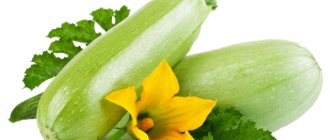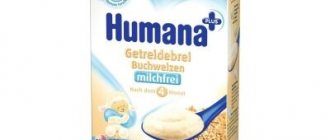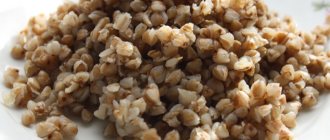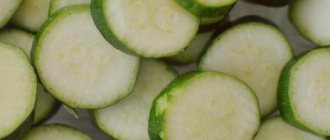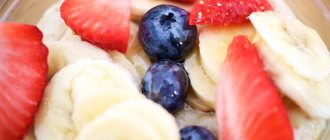Cooking method
To prepare porridge, only well-washed and dried cereals are suitable. Next, the dried cereal should be ground to obtain a homogeneous mixture that does not contain unground pieces. A blender or even a simple coffee grinder is suitable for this. When using a coffee grinder, you must act carefully to prevent coffee particles from getting into the grains. If you don’t want to grind the cereal, you can first cook porridge from it, and then grind it in a blender.
It is very important to remember that your child’s first porridge should be prepared exclusively with water. Adding cow's milk can lead to allergies, rashes and cow's protein intolerance. Many mothers add breast milk or infant formula to improve the taste of cooked porridge. This dish is not only tasty, but also more satisfying and healthy.
When preparing porridge for the first feeding, it is very important to maintain proportions. The thickness of the prepared dish will depend on this. If the mother is going to feed the baby with a spoon, then the prepared dish should resemble the consistency of liquid soup. To prepare, you need to take about 1 teaspoon of ground cereal (rice, buckwheat) and pour 100 ml of hot boiled water into it, mix thoroughly, and cook on the stove. Then cool to the required temperature and you can start feeding. If you plan to bottle feed your baby, the resulting porridge should be less thick. To prepare this dish you will need a little less than a teaspoon of cereal.
You should never use a microwave oven when preparing porridge for your baby. Microwave radiation can have a detrimental effect on the growth and development of a child. This is why you should use only gas or electric stoves to prepare any food for children.
How to prepare porridge for first feeding
Cereals add variety to the baby's diet and replenish the body's energy reserves. Preferring the home method of cooking, the mother faces the question of how to prepare porridge for the first feeding and preserve all the useful microelements.
Table of contents
|
Choice of cereals
According to WHO, grains are the second stage of complementary feeding for infants, both breastfed and bottle-fed.
Cereal complementary foods are introduced after the baby is introduced to vegetables.
Up to 6 months, infants receive lactotrophic nutrition (milk) and enzymes for digestion are supplied with breast milk or formula.
Vegetables help prepare the digestive system to digest richer foods by stimulating the production of enzymes by the pancreas and liver.
Without preparing the digestive system, cereals will not benefit the body. Lack of enzymes will lead to indigestion and nutrients will not be absorbed, and the body will waste energy breaking down food.
Cereals for first feeding must meet the following criteria:
- Hypoallergenic.
- Gluten free (complex protein).
- Quality (top grade).
For medical reasons, cereals are included first in a child’s menu (underweight).
Cereals contain slow carbohydrates, and take longer to digest in the gastrointestinal tract than vegetables (up to 4 hours).
Blood sugar levels gradually increase. Absorption of nutrients from the intestines occurs in several stages - this allows you to prolong the feeling of fullness.
How to choose quality cereals
For the first complementary foods, pediatricians advise choosing rice or buckwheat groats. These grains do not cause allergies and are completely digestible.
Buckwheat kernels are rich in iron and B vitamins. For constipation, porridge helps improve the functioning of the intestinal tract.
Useful tips for mothers: First complementary foods
Rice grains contain a lot of starch, which coats the mucous membranes of the gastrointestinal tract. For diarrhea, porridge helps retain water and prevent dehydration.
Buckwheat has a more saturated chemical composition; rice loses many valuable microelements during processing (grinding).
The pediatrician will advise which porridge to start complementary feeding with, since the child’s overall development and compliance with standards are taken into account.
What to look for when choosing grains:
- degree of kernel purification;
- whole or crushed grains in packaging;
- color;
- impurities in packaging (husks, garbage);
- smell.
You can only examine cereals in transparent packaging or if the grain is sold in open containers (bags). The quality of grains and processing technology affects the nutritional value of cereals.
High-quality buckwheat is called kernels (grade 1). The kernels are placed in a package whole and peeled from the fruit shell. The highest grade of cereal has a light brown color.
Poor quality of raw materials is indicated by crushed and broken grains, as well as an admixture of garbage and husks.
The highest grade of rice has the inscription on the packaging - polished. The split grains are of low grade because they are considered a waste product from rice processing.
High-quality grain is white, without a yellow tint. The grains should be the same size, even with a smooth surface. The polished grains are well cleaned and have no shine.
When choosing cereals, you should pay attention to the smell. If even a faint smell of spoilage is felt, this indicates a violation of the temperature regime of storage.
High humidity is a habitat for fungi. Rotted cereal can be dangerous to the baby's health.
We cook it ourselves
Cow's milk is not used to prepare the first cereal supplement.
A child's digestive system is not yet ready to digest and absorb the complex protein casein.
Cereals for infants are prepared in water or vegetable broth. It is forbidden to add sugar and salt to the dish.
Porridge for first feeding is prepared from only one type of cereal. This is necessary to adapt the gastrointestinal tract and monitor allergic reactions.
Before cooking, the grains are sorted and thoroughly washed under running water. Pre-dried cereals (in the oven) can be ground into flour - this will speed up the preparation of the dish.
It is recommended to soak rice in warm water for several hours to remove excess starch.
The baby's first cereal complementary food is boiled to a liquid consistency so that it does not cause difficulty in swallowing.
The finished dish should be homogeneous. The volume of a serving of cereal complementary foods should not exceed 150 milligrams.
The presence of teeth does not indicate a baby's readiness to chew food. The chewing reflex has not yet been formed; thick food or lumps in porridge will cause a gag reflex.
The first feeding starts with 5% porridge. To do this, strict proportions of cereal and water are observed - 1 teaspoon of cereal (flour) is added to 100–120 milliliters of liquid.
Thicker porridges – 10%, can be cooked after a few weeks.
The cereal is poured into cold water and cooked for no more than 20 minutes over low heat, stirring occasionally.
It is forbidden to add water (broth) during the cooking process. Grind the finished dish with a blender until smooth.
The flour is gradually poured into boiling water. The porridge must be constantly stirred, otherwise the grind will stick together and the dish will not be suitable for baby food.
Cooking time 5-7 minutes over low heat. Next, the dish is infused for 10 minutes.
If cereal flour is cooked immediately until cooked, it can cause a feeling of heaviness in the baby and provoke gas formation, as it begins to swell in the stomach.
Gastroenterologists advise preparing the dish from whole grains. When grinding cereal in a coffee grinder, most of the microelements are lost. After adaptation of the gastrointestinal tract, the cereals can be mixed and cooked as a multi-grain porridge.
You can make the dish taste sweet by adding a little fruit puree.
If the child refuses new food, then breast milk or formula is added to the finished dish - this will give a feeling of familiar taste.
Features of cooking buckwheat
The kernel has a fairly dense coating that protects it during heat treatment. The film retains the starch inside the grains.
Cooking buckwheat porridge is not difficult, but if the rules are not followed, the taste of the prepared dish changes.
Recommendations:
- cooking utensils must be metal with a thick bottom;
- the lid should fit tightly to the pan (ladle);
- the ratio of water and flour (cereals) must be strictly maintained;
- after boiling, reduce the heat to low (low simmer).
Buckwheat porridge cooks faster if you lift the lid to stir as little as possible.
The concentration of steam inside the pan will prevent the porridge from burning and make the taste more delicate.
Despite the speed of preparation, any heat treatment leads to a partial loss of minerals and trace elements.
Preparing a small portion size gives mother a lot of trouble, since only freshly prepared dishes are served for infants.
Soaking the kernels in a thermos will help preserve all the benefits of cereals and simplify preparation.
The grains are poured with slightly cooled boiled water and left for 5–6 hours. The thermos maintains the temperature of the water, the grains absorb the liquid and swell.
By soaking the kernels overnight, in the morning you can get a tasty and healthy porridge; all you have to do is grind it in a blender.
Features of cooking rice
When choosing rice for cooking porridge, it is better to give preference to the white round variety - it boils faster.
If rice porridge is included in a child’s menu to eliminate gastrointestinal disorders (diarrhea), then it is better not to soak the cereal.
Prolonged stay of grains in water washes away starch, which is necessary for enveloping the mucous membrane of the digestive tract.
It will be enough to simply rinse the cereal several times under running water.
The cooking utensils should have thickened walls and a bottom - this will prevent the grains from burning.
It is recommended to add rice after boiling water and stir once after boiling again. The porridge is cooked under a tightly closed lid over low heat.
If rice flour is used to prepare porridge, then it is first diluted in a glass with a small amount of cold water.
After the water boils in the pan, pour the resulting mixture in a slow stream, stirring constantly - this will prevent the flour from sticking together into lumps.
High-quality cereals and compliance with the rules of first complementary feeding will help avoid negative reactions.
Cereal complementary foods are the basis of a balanced diet.
Anna Yan
PSYCHOLOGIST Education: — Alexander Medical College, specialty “nursing”; — Vladimir State University, psychologist, psychology teacher. Mother of two children
Which cereal is better?
Pediatricians say that buckwheat porridge is the most suitable, indeed, the only correct choice for mothers to introduce the first complementary foods at the age of 6 months.
Buckwheat is a unique grain containing a huge amount of beneficial nutrients. It also contains organic acids - linoleic, citric, oxalic, etc.; vitamin complex – vitamins B, C, E, PP; as a source of energy - carbohydrates and even calcium, necessary for the proper development of the musculoskeletal system; magnesium, potassium - for normal functioning of the heart muscle; selenium and zinc – for the proper functioning of the nervous system.
This composition has a beneficial effect on the immune system of a baby in the first year of life and activates T cells in the fight against infections and other diseases. Solid dietary fiber contained in buckwheat porridge helps digest food, enhance intestinal motility and improve metabolism. That is why buckwheat will not cause problems in the baby’s gastrointestinal tract.
The absence of gluten in this cereal is also the most important aspect when choosing porridge for the first feeding. Unlike everyone’s favorite semolina or oatmeal, buckwheat is devoid of this complex protein, which has long been recognized by the Russian pediatric community as harmful to the growth and development of infants. And the iron content in buckwheat porridge is five times higher than in rice and semolina.
Making puree
Before cooking, vegetables must be thoroughly washed, but without soap, peeled, seeds removed and finely chopped or disassembled into inflorescences. It is advisable to soak the potatoes in water for 2-3 hours and then drain it. Mashed foods can be prepared in several ways:
- For a couple. The most useful option. Place pieces of vegetables on the top tier of the steamer and cook until soft. The vegetable broth that has formed at the bottom does not need to be poured out; it can be useful for giving the dish a uniform consistency
- Baking. Place the chopped vegetables in a heat-resistant form, pour boiling water so that the water covers them halfway, cover with a lid (foil) and simmer in the oven
- Cooking. Pour some water into the pan, bring it to a boil, throw in the pieces of vegetables (the water should cover them) and cook under the lid, reducing the heat
With this method, many microelements are lost, but it does not require special devices. Cooking time depends on the vegetable: zucchini will take 5 minutes, cauliflower and pumpkin will need 10, and potatoes and carrots will need 20-25. Ready hot vegetables should be blended in a blender along with vegetable broth or rubbed 2-3 times through a sieve. Simply mashing them with a masher will not be enough - all the fibers will be preserved, and the baby’s stomach will not be able to digest them. You can add mixture or milk to the puree. Salt and sugar are not needed. A month and a half after the introduction of complementary foods, you can drip a little vegetable oil into your dishes. But this is a new product, so you need to be careful with it.
Watch a video about making your own vegetable puree for babies
The first feeding is an important event for both the child and his parents. In order for your baby’s introduction to the world of adult food to be successful, you need to take care of quality products and prepare them correctly. But the most important thing is to create a positive attitude, then the baby will definitely not refuse a healthy spoon of puree or porridge.
Method for preparing buckwheat porridge
To prepare it, you cannot choose dark-colored cereals; buckwheat should have a light brown tint. Grind the cereal in a blender to obtain a homogeneous mixture.
To prepare, you need to take one teaspoon of buckwheat flour and pour 100 ml of hot boiled water into it, mix thoroughly, cook on the stove for no more than 10 minutes. You should have the consistency of a liquid puree soup. Cool to desired temperature.
To properly introduce complementary foods, you should consult your pediatrician. Usually just one teaspoon will be enough for the first time. If the baby happily and without consequences ate the new treat offered to him, then the portion can be gradually increased and brought to 150 grams per feeding. Complementary foods are given only after the main feeding. They prepare 10% porridge for a child of the first year of life. More concentrated food can harm intestinal function. To prepare a dish of the required consistency, take 10 g of porridge and 100 g of water.
Types of porridges
Depending on the method of preparation, baby porridges are divided into:
- Soluble. Produced by leading baby food manufacturers. They don't need to be boiled. The porridge is diluted with warm boiled water.
- Ready. You can find ready-made porridges. It is recommended to warm them slightly to room temperature and give them to the child. They are convenient on the road or for a walk.
- Homemade . They are prepared from ground cereals. Doctors usually do not recommend starting complementary foods with them.
Based on their composition, porridges are divided into dairy and dairy-free. They begin to introduce the baby to new foods with dairy-free ones. Cow's milk is considered a strong allergen and can be introduced into a child's diet after one year.
Porridges are also divided into gluten-containing and gluten-free.
Gluten is a protein found in some grains. In extremely rare cases, it is not absorbed by the body. Therefore, it must be abandoned. It can also cause allergies in children prone to atopic diathesis.
According to the number of types of cereals, porridges are single-component and multi-component (contain 2, 3, 5, 7 types of cereals).
Main classification
There are two varieties on the market today:
- containing milk (dairy);
- dairy-free
For the first complementary feeding, a product that does not contain milk is suitable. At an older age, the introduction of milk porridge is welcome. But if a child cannot tolerate cow’s milk protein, then dairy-free dishes are a way out of this situation. Both types are completely balanced and adapted to the baby’s age, containing all the nutrients he needs.
The second classification of cereals is based on gluten content:
- gluten-containing;
- gluten-free.
It would be right to opt for gluten-free porridge, since the baby’s body still does not digest this complex protein well.
The leaders among them are corn, buckwheat and rice. You need to introduce them into your baby’s diet little by little in order to understand which porridge the child likes best and is best suited for him. For children suffering from constipation, a store-bought mixture of rice porridge is suitable, rather than home-grown rice cereal.
Ready-made mixture or homemade porridge?
Baby food undergoes strict quality control procedures. The raw materials used are tested in a laboratory and undergo special processing. Such dishes contain vitamins and mineral salts. They do not require the use of additional additives to improve taste.
Ready-made baby food has a homogeneous consistency. That's why they turn out smooth and tender. They are ideal for children's digestive system. The risk of developing intestinal upset or indigestion is minimized.
Baby food is prepared quickly. It is inconvenient to cook a few teaspoons of porridge yourself, which the child may also refuse. It is enough to take the required amount of powder and dilute it with water.
Cooking method
To prepare porridge, only well-washed and dried cereals are suitable. Next, the dried cereal should be ground to obtain a homogeneous mixture that does not contain unground pieces. A blender or even a simple coffee grinder is suitable for this. When using a coffee grinder, you must act carefully to prevent coffee particles from getting into the grains. If you don’t want to grind the cereal, you can first cook porridge from it, and then grind it in a blender.
It is very important to remember that your child’s first porridge should be prepared exclusively with water. Adding cow's milk can lead to allergies, rashes and cow's protein intolerance. Many mothers add breast milk or infant formula to improve the taste of cooked porridge. This dish is not only tasty, but also more satisfying and healthy.
When preparing porridge for the first feeding, it is very important to maintain proportions. The thickness of the prepared dish will depend on this. If the mother is going to feed the baby with a spoon, then the prepared dish should resemble the consistency of liquid soup. To prepare, you need to take about 1 teaspoon of ground cereal (rice, buckwheat) and pour 100 ml of hot boiled water into it, mix thoroughly, and cook on the stove. Then cool to the required temperature and you can start feeding. If you plan to bottle feed your baby, the resulting porridge should be less thick. To prepare this dish you will need a little less than a teaspoon of cereal.
You should never use a microwave oven when preparing porridge for your baby. Microwave radiation can have a detrimental effect on the growth and development of a child. This is why you should use only gas or electric stoves to prepare any food for children.
Which cereal is better?
Pediatricians say that buckwheat porridge is the most suitable, indeed, the only correct choice for mothers to introduce the first complementary foods at the age of 6 months.
Buckwheat is a unique grain containing a huge amount of beneficial nutrients. It also contains organic acids - linoleic, citric, oxalic, etc.; vitamin complex – vitamins B, C, E, PP; as a source of energy - carbohydrates and even calcium, necessary for the proper development of the musculoskeletal system; magnesium, potassium - for normal functioning of the heart muscle; selenium and zinc – for the proper functioning of the nervous system.
This composition has a beneficial effect on the immune system of a baby in the first year of life and activates T cells in the fight against infections and other diseases. Solid dietary fiber contained in buckwheat porridge helps digest food, enhance intestinal motility and improve metabolism. That is why buckwheat will not cause problems in the baby’s gastrointestinal tract.
The absence of gluten in this cereal is also the most important aspect when choosing porridge for the first feeding. Unlike everyone’s favorite semolina or oatmeal, buckwheat is devoid of this complex protein, which has long been recognized by the Russian pediatric community as harmful to the growth and development of infants. And the iron content in buckwheat porridge is five times higher than in rice and semolina.
Two options for porridge for introducing complementary foods:
- ready from the store;
- home cooked.
Industrial cereals suitable for first feeding
The modern food industry offers a lot of cereals for complementary feeding of a child in the first year of life, and it is not always easy for a young mother to navigate this variety.
The range of industrial cereals in stores is very large
Since cereals for the first feeding should be dairy-free, you should look for this kind of marking on the packaging. In addition, the product should not contain sugar, salt and various “dubious” additives (preservatives, thickeners, flavorings, etc.). Many popular brands meet these requirements.
Table: review of popular brands of children's dairy-free cereals
| Brand | Assortment of dairy-free cereals | Peculiarities |
| Foreign production | ||
| Heinz (USA) |
|
|
| Nestle (Switzerland) |
|
|
| Fleur Alpine (Germany) |
|
|
| Remedia (Israel) |
|
|
| Baby Sitter (Israel) |
|
|
| Bebi (Slovenia) |
|
|
| Hipp (Germany) |
| Porridges are enriched with vitamins, minerals, and prebiotics. |
| Gerber (USA) |
|
|
| Domestic production | ||
| Vinny |
| Porridges are enriched with vitamins, minerals, and prebiotics. |
| Frutonyanya |
|
|
| Baby |
|
|
| Swaddle |
|
|
Method for preparing buckwheat porridge
To prepare it, you cannot choose dark-colored cereals; buckwheat should have a light brown tint. Grind the cereal in a blender to obtain a homogeneous mixture.
To prepare, you need to take one teaspoon of buckwheat flour and pour 100 ml of hot boiled water into it, mix thoroughly, cook on the stove for no more than 10 minutes. You should have the consistency of a liquid puree soup. Cool to desired temperature.
To properly introduce complementary foods, you should consult your pediatrician. Usually just one teaspoon will be enough for the first time. If the baby happily and without consequences ate the new treat offered to him, then the portion can be gradually increased and brought to 150 grams per feeding. Complementary foods are given only after the main feeding. They prepare 10% porridge for a child of the first year of life. More concentrated food can harm intestinal function. To prepare a dish of the required consistency, take 10 g of porridge and 100 g of water.
Main classification
There are two varieties on the market today:
- containing milk (dairy);
- dairy-free
For the first complementary feeding, a product that does not contain milk is suitable. At an older age, the introduction of milk porridge is welcome. But if a child cannot tolerate cow’s milk protein, then dairy-free dishes are a way out of this situation. Both types are completely balanced and adapted to the baby’s age, containing all the nutrients he needs.
The second classification of cereals is based on gluten content:
- gluten-containing;
- gluten-free.
It would be right to opt for gluten-free porridge, since the baby’s body still does not digest this complex protein well.
The leaders among them are corn, buckwheat and rice. You need to introduce them into your baby’s diet little by little in order to understand which porridge the child likes best and is best suited for him. For children suffering from constipation, a store-bought mixture of rice porridge is suitable, rather than home-grown rice cereal.
When porridge is introduced into complementary feeding for a baby
According to the recommendations of the WHO and many modern Russian and foreign pediatricians (including Dr. E. Komarovsky), complementary feeding should be introduced to an infant from 6 months. Moreover, this does not depend in any way on the method of feeding - breast, artificial or mixed.
If the baby is developing well, has normal weight and does not experience problems with stool, then doctors usually recommend offering vegetable purees as the first “adult” product. Accordingly, porridge is introduced into the child’s diet a little later (after 1.5–2 months). However, in some situations it is advisable to use a cereal dish as a first complementary food:
- If the baby is not gaining weight well. All porridges are very nutritious and high in calories, which will allow the baby to soon gain the fatness that so touches parents.
- The child is prone to diarrhea. Porridge solves this problem by providing a fixing effect.
- The baby is anemic. In this case, buckwheat will be especially relevant. In addition, many industrial baby cereals are additionally enriched with iron and other valuable microelements.
By the way, if there are any of these problems, then the pediatrician may individually allow porridge to be introduced into the baby’s diet earlier than the generally accepted period (for example, at 4 or 5 months).
Porridge may well become a baby’s very first adult dish at 6 months, and sometimes earlier
Video: complementary feeding (Dr. Komarovsky explains)
Dr. E. Komarovsky will highlight porridge as one of the options for first complementary foods (along with vegetable purees and fermented milk products).




